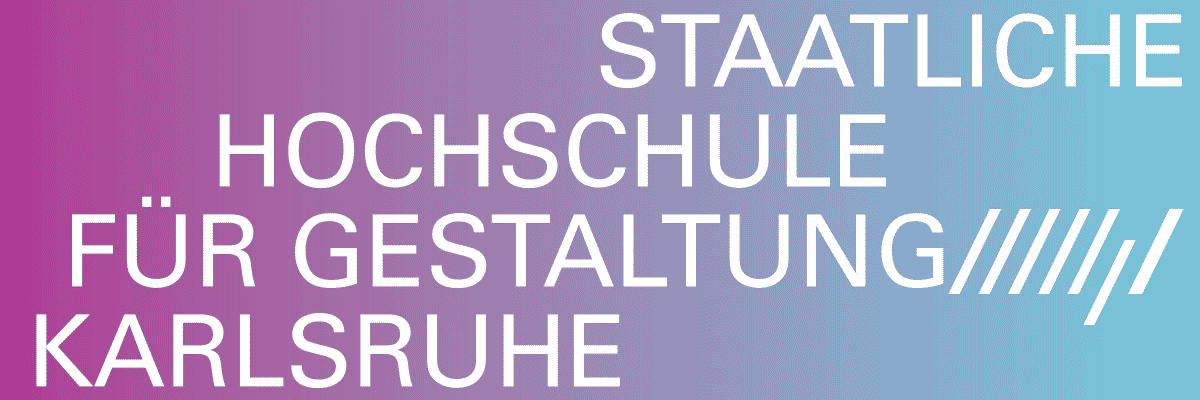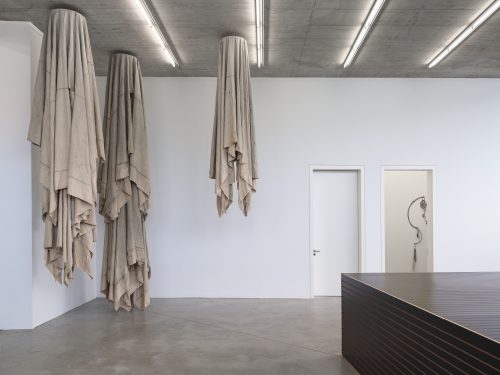
Ilê Sartuzi
Trick
Project Info
- 💙 Museum of Contemporary Art, São Paulo
- 💚 Marcela Vieira
- 🖤 Ilê Sartuzi
- 💜 Marcela Vieira
- 💛 Ilê Sartuzi
Share on

trick, 2025 Installation view at the Museu de Arte Contemporânea da USP
Advertisement

map and technical details of the exhibition Trick silver gelatin print, acetate, red pen and acrylic 41.5 x 33.3 cm and 21.5 x 34 cm

Bosch (The Conjurer, MAC-USP), 2025 photocopy of a book found in the Walter Zanini Library at MAC-USP, stamp, lightening gel, magnets 29.7 x 21 cm

The Vanishing Coin (forgery), 2023-2025 oil on linen, black velvet and pins 30.5 x 40.5 cm

Watchman, 2023-2025
security camera, aluminum, DC motor, signal converter and TV variable dimensions

Turn Me Off, 2023-2025
switch, microcontroller, relay, speaker variable dimensions

Signal, 2021-2025
modified museum lights, microcontroller, relays variable dimensions

beep 2023-2025
buzzer, microcontroller, laser and sensor modules variable dimensions

beep 2023-2025
buzzer, microcontroller, laser and sensor modules variable dimensions

Sleight of Hand, 2023-2024 two-channel video installation colour, sound, 8’43’’

Sleight of Hand, 2023-2024 two-channel video installation colour, sound, 8’43’’

trick, 2025 Installation view at the Museu de Arte Contemporânea da USP

Bosch, 2025 silver gelatin print 48 x 32.8 cm

trick, 2025 Installation view at the Museu de Arte Contemporânea da USP

Sleight of Hand (document II), 2023-2024 scanned image from 35mm film of the original coin being handled by the artist on one of his many visits to the British Museum

Sleight of Hand (document V), 2023-2024 scanned image from 35mm film of the original coin
in the British Museum donation box

Sleight of Hand (letters), 2024
letters exchanged between the British Museum's Legal Services and the artist variable dimensions, 7 copies on 21 x 29.7 cm paper and translations + 10 x 15 photographs

scan of the book “Faces da Moeda” showing the first coin produced in Brazil, minted by the Dutch in 1645, coinciding not only with the year of the British stolen coin but also the format.

Sleight of Hand (coins), 2023-2025
two counterfeit coins on museum display 132 x 60 x 60 cm

Sleight of Hand (Subject Access Request), 2024-2025
documents about the artist held by the British Museum variable dimensions, 56 copies on paper 21 x 29.7 cm
The exhibition “Trick” consists of a series of subtle interventions — similar to magic tricks — that reveal infrastructural elements of institutional spaces dedicated to culture and art. These works involve technological security elements that are often invisible, playing with the visitor’s experience and focusing attention on peripheral aspects of the museum environment. The exhibition has two main cores: one of them orbits around “Sleight of Hand” (2023-2024) and the other is a series of “Propositions for museum security systems” (2023) that were first published in text format in Revista Rosa.
I. Sleight of Hand
Testing the boundaries of the law, London-based Brazilian artist Ilê Sartuzi performed a sleight of hand, temporarily “stealing” a historical coin from the collection of the British Museum. After more than a year of planning, the artist secretly exchanged a 1645 silver coin minted in Newark during the English Civil War with a fake replica. With the coin under his possession, the artist left Room 68 – the money section of the British Museum – and went downstairs to deposit the object in the donation box of the museum.
“Sleight of Hand” is a trick. It is also a short-circuit. It introjects back to the institution their own (historical) issues. Formally, this work is a simple and direct gesture. It has the elegance of a magic trick, a “legerdemain” that, if not intentionally highlighted, could go unnoticed. In a way, the gesture also resonates Francis Alÿs iconic motto “maximum effort, minimum result”. It is almost silly in its banality. The countless hours spent visiting the British Museum (over twenty times in a year) to map the working schedule of the volunteers contrasts with the split of the second of the sleight of hand and the elasticity of time on the day of the actual heist.
Beyond the provocations of incorporating this figure of the trickster, thinking about sleight of hand as a form, misdirection as procedure and stealing as art; this project raises debates around value, property, the historical violence of law and its role in legitimizing looting as a tool for the foundation of “universal museums” such as the institution in question. By returning the coin to the donation box of the museum, it not only denounces these infamous imperialist bases of said institutions but opens a speculation about the organization of this infrastructure and its administration. As a trick, it both misdirects the attention but also creates a full circle back to the same place. In a scale dimension, the gesture – as small as it is – inverts dynamics of power with the museum, flipping the relation between the colonial authority and the colonial subject.
The fact that the artist chose a coin as the target object of this heist points to an interest in the nature of money as a social construct and medium of exchange that is based on a “leap of faith”. This fetishistic character of money as a form is closely related with the experience of the “momentary suspension of disbelief” that is the basis of magic.
Documentation of this work was first shown at the MFA graduate exhibition at Goldsmiths (London). A two-channel video installation featuring footage of the heist and planning material was shown alongside two replicas of the coin in a museum display and a text. Each new presentation of the work now incorporates different documents that were not in the first exhibition, as well as new works that have been developed around this same project.
II. Some propositions for museum’s security systems
Some of the works included in “Trick” were first published in Revista Rosa. Conceptually, these pieces explore different modes of circulation and existence within the art circuit, adapting to various contexts of exhibition and accessibility. Their minimalist interventions in the exhibition space make them less about visual spectacle and more about sharpening the viewer’s perception of infrastructural elements that usually go unnoticed. In this way, Sartuzi animates security cameras, sensors and alarms, switches and lights.
Gestures and Spaces for Brand-New Meanings
Marcela Vieira
curator
There are various ways, conscious or not, of entering a space and generating meanings, associations, and, by extension, new memories. Some may step into a space and allow themselves to be captivated by a word, a fleeting impression—an event belonging to the enigmatic domain of affect. Others may engage with space by scrutinizing its angles, planes, quadrants, and light. The distinction between these modes of perception, which we continuously experience, is subtle and often unspoken. Yet, these dynamics are always susceptible to representation through narrative or speculative means.
Nothing, however, prevents different ways of experiencing movement through space from merging, giving rise to exceptional occurrences: structural perceptions shifting into the realm of sensation or, conversely, sensory impressions assuming a geometric register, shaped by movement and rhythmic cadence. Ilê Sartuzi's exhibition Trick, installed at MAC USP, explores these observational and spatial possibilities, simultaneously revealing the structure (and infrastructure) of the exhibition space and activating the body's properties through meticulously choreographed movement.
***
During the production of Trick, Sartuzi's approach was particularly remarkable. It involved meticulous research into the museum's structure and agreements with different institutional bodies, including curators, the security team, and the fire department, all of whom engaged in negotiations regarding the architectural scope. On one hand, there was a strong commitment to spatial considerations, evident in the study of the floor plan—an element that is integrated into Trick as both documentation or, if we want, an independent artwork. Equally noteworthy is the fact that many of these works—Turn Me Off, Signal, False Alarm: Symphony for Museums, Vigilant, and beep—emerged from a speculative process, originating as text. This aspect is particularly intriguing, as it reveals that before making visual and aesthetic decisions, Sartuzi engaged in a primarily technical approach, gathering vocabulary, perspectives, and conceptual frameworks related to his subject. Before finally arriving at the image—which potentially embodies novelty or, ideally, the possibility of transformation—Sartuzi’s process often draws upon a variety of linguistic models, including literature, architecture, theater, and choreography.
The two-channel video Sleight of Hand, recorded at the British Museum in London and now exhibited in Trick, confirms Sartuzi's interest in the study of space. However, this time, the exhibition space is strategically approached as the stage for an operation that lies between theft and magic, exploring what these two activities have in common. (Sleight of hand refers to the illusionistic manipulation of an object, making it disappear before the eyes of the other.) To execute this carefully premeditated move, the presence of another person is necessary, because without them, neither the magic nor the theft would be completed and would simply remain as mere practice. For the sleight of hand to be successfully performed, the magician or thief must navigate a complex system of signs, involving rhythmic, spatial, visual, and psychological elements. Because the outcome depends not only on the performer's actions but also on external factors, the thief or magician remains acutely attuned to external agents beyond their own gestures or movements. This is why even the most perfected preparation for the act involves a significant margin of error. When successful, it is not the act itself but the consequences—the gesture, the pass—that is revealed by both theft and magic.
The operations proposed by the tricks require a reconfiguration of gestures and the creation of rhythmic dynamics between the bodies, aiming to inscribe themselves within the supposedly natural order of the situation in which they are about to intervene. Flowing within the rhythm, even if only to participate synchronically, implies an intervention in reality, with the intention of camouflaging oneself within it, simulating spontaneity. From the operation of concrete and real elements, a transformation can happen, opening up new possibilities for perception. In Sleight of Hand, the magical action, or theft, performed by the artist leads to a shift in meaning, paving the way for a language that can be utopian and effusive, while also offering a critical perspective on the reality it engages with.
Another recurring element in Sartuzi's poetics emerges in Sleight of Hand: the study of bodies. While in previous works these bodies are represented in mechanized or artificially altered forms, often through dismantled mannequins, in Sleight of Hand, the characters are real and experience intense apprehension in response to the situation they face. Because they are anonymous—their faces never revealed to us—and silent (the video is accompanied only by a soundtrack that accentuates the rhythm and ambiguity of the outcome), our attention, as viewers, is directed toward the improvised choreography that was intuitively necessary for the success of the project.
And speaking of choreography and spatial configurations, we are invited to experience the exhibition not merely as spectators, but as agents capable of activating its structures, making the environment "speak" and respond to our paths and movements. However, one work in Trick challenges us—partly due to its pictorial nature, which contrasts with the exhibition’s technological explorations: The Vanishing Coin, a replica created by an anonymous art forger whom Sartuzi entrusted with the task of precisely replicating a painting of his own, introduces yet another anonymous body into the exhibition. The concealed identity of the depicted figure shifts the focus to the coin and the gesture that holds it. This painting emerges as an enigma, evoking a mise en abyme effect within an exhibition shaped by reproductions, forgeries, replicas—or, if we prefer, tricks—where meticulous layers of self-reference unfold like Russian dolls, encompassing choreographic, conceptual, and, in a broader sense, critical reflections on the institutional context and the circulation of art itself.
Marcela Vieira




